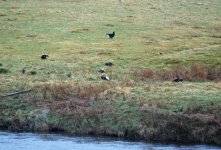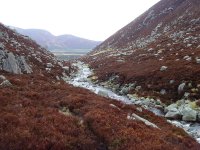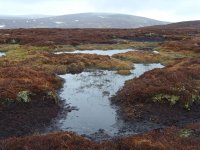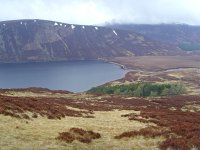No38b
I did my first breeding TTV of the year today - NO38B (
Map). This is a remote tetrad in Glen Muick in Aberdeenshire, at the end of an 8 mile single track road. Due to the snow I hadn't managed to do my winter visits to this tetrad, so it was good to finally reach it today. The weather wasn't that great today either, only 3 Celsius when I parked the car and light drizzle turning to snow above 600m, but still some decent birds.
Driving up Glen Muick, I passed a lek with 9 Blackcock and 2 Greyhens still strutting about at 10am and then walking up the Allt Darrarie from the Spittal of Glen Muick, I flushed a Ring Ouzel and two Wheatears from the side of the path before I even got to my tetrad. The first part of the 1 hour TTV was a clamber up steep boulder and heather slopes, with a couple of
Meadow Pipits and another
Ring Ouzel here. Once I got onto the peaty plateau at the top I flushed the first of 11
Red Grouse and started seeing and hearing more Meadow Pipits (the count for the hour was 34).
It was fairly hard going through the heather and I decided against going to the highest point of the tetrad as I wanted to reach a small forestry plantation lower down the other side of the hill before the hour was up. Descending towards Loch Muick, I heard a
Snipe 'chipper-chipper-ing' from a wet flush on the slopes to my right and later heard another drumming.
Approaching the trees, I encountered more
Black Grouse - three Greyhens flushed from the tree tops, followed by nine Blackcocks, which landed on the ground next to the plantation and started displaying, oblivious to walkers on the path below. The trees also held a small number of
Willow Warblers,
Chaffinches and a
Mistle Thrush. A
Buzzard, pursued by a
Carrion Crow briefly appeared above the ridge behind me and the last bird of the hour was a
Curlew, displaying close to the loch.
Returning to the car park, I passed no less than 25 Blackcocks loafing on the grassy flats at the bottom of the glen, bringing my Black Grouse total for the day up to an impressive 48.








